Kitwanga Smolt Enumeration Facility
Since 1999, the Gitanyow Fisheries Authority (GFA) has been studying the limiting factors affecting sockeye salmon production in the Kitwanga Watershed. One of the highest assessment priorities for the Kitwanga Sockeye Salmon Recovery Plan (KSRP - initiated in 2006), was to annually monitor the health and abundance of Kitwanga sockeye salmon smolts migrating from Gitanyow Lake, down the Kitwanga and Skeena Rivers, to the Pacific Ocean.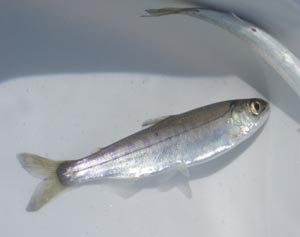
Since 2002, GFA with support from Fisheries and Oceans Canada (DFO) stock assessment biologists, have experimented with different weirs and traps in an effort to accurately enumerate Kitwanga sockeye smolt production.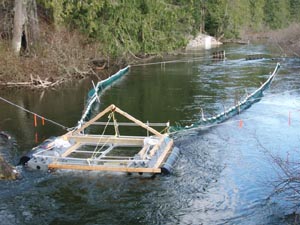 However, the weirs and traps tested all had one major limitation - they were often inoperable during the high water period, which is also the peak of smolt out-migration. Therefore, GFA with the help of DFO engineers, designed a permanent smolt fence that would be constructed from concrete and aluminum at the outlet of Gitanyow Lake (aka Kitwanga or Kitwancool Lake).
However, the weirs and traps tested all had one major limitation - they were often inoperable during the high water period, which is also the peak of smolt out-migration. Therefore, GFA with the help of DFO engineers, designed a permanent smolt fence that would be constructed from concrete and aluminum at the outlet of Gitanyow Lake (aka Kitwanga or Kitwancool Lake).
In 2007, the GFA were successful in acquiring funding from the B.C. Ministry of Forests (MoF), Ministry of Environment (MoE), Gitanyow Hereditary Chiefs (GHC) and DFO to complete Phase I construction of a permanent smolt fence. Phase I consisted of the establishment of a concrete sill in the Kitwanga River from which aluminum transoms could be erected to support fence panels (successfully constructed in the spring of 2007 at a cost of $100,000).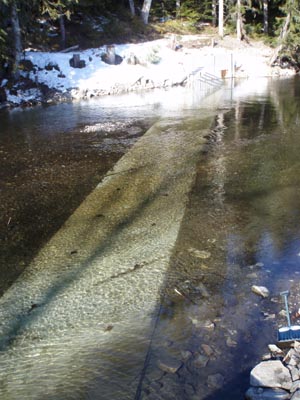 In 2008, the GFA acquired funding from the Pacific Salmon Commission (PSC), MoF, GHC and DFO to initiate Phase II, which included the fabrication and construction of the aluminum fence components to make the permanent smolt fence operational (successfully implemented in March of 2008 at a cost of $100,000).
In 2008, the GFA acquired funding from the Pacific Salmon Commission (PSC), MoF, GHC and DFO to initiate Phase II, which included the fabrication and construction of the aluminum fence components to make the permanent smolt fence operational (successfully implemented in March of 2008 at a cost of $100,000).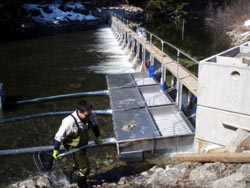
Why is the smolt fence such a vital component in the rebuilding of the Kitwanga sockeye stocks??
1) In 2007 and 2008, hatchery raised sockeye fry were released into Gitanyow Lake. The smolt fence allows a direct calculation of the fry-to-smolt survival rates, as it allows the observation of each smolt for a missing adipose fin - the permanent mark given to the hatchery raised sockeye.
2) The smolt fence allows biologists to get a measure of absolute abundance of sockeye smolts migrating from the system - a measure which is rarely obtained in any field of population biology. In combination with the KRSEF (the counting fence which allows GFA to determine absolute abundance of spawning salmon), GFA biologists are able to calculate the # of smolts produced per female that enters the system, therefore enabling the determination of the overall success of spawning, incubation and rearing (i.e. freshwater survival rates).
3) And also the reverse of that - GFA biologists are able to determine the number of spawners that return based on the number of smolts that migrate from the system, therefore enabling the determination of sockeye marine or ocean survival rates.
In addition to the main benefits of the smolt fence listed above, there have also been some important indirect benefits and uses of the program:
1) The smolt fence captures adult cutthroat trout as they migrate downstream from Gitanyow Lake into the Kitwanga River to spawn.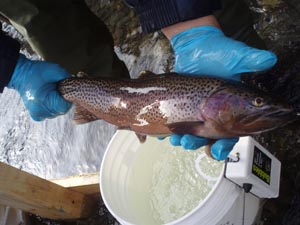 GFA, on behalf of the B.C. Ministry of Environment, has been obtaining valuable age structure (lengths, weights, scales, condition) information from cutthroat trout, as well as applying T-bar tags and assisting in implementation an education program for anglers to record and report the presence of tags in captured fish. As well, GFA is able to enumerate the annual run of cutthroat spawners into the Kitwanga River each spring.
GFA, on behalf of the B.C. Ministry of Environment, has been obtaining valuable age structure (lengths, weights, scales, condition) information from cutthroat trout, as well as applying T-bar tags and assisting in implementation an education program for anglers to record and report the presence of tags in captured fish. As well, GFA is able to enumerate the annual run of cutthroat spawners into the Kitwanga River each spring.
2) Bull trout and Dolly Varden are captured in the smolt fence, as they migrate downstream feeding on sockeye smolts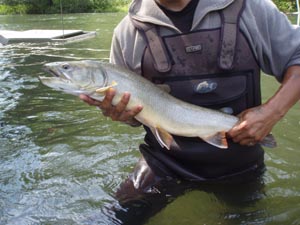 . These fish are enumerated and lengths and weights are recorded, providing valuable information on the annual out-migration of these species from Gitanyow Lake.
. These fish are enumerated and lengths and weights are recorded, providing valuable information on the annual out-migration of these species from Gitanyow Lake.
3) A significant portion of Kitwanga coho rear to smolt stage upstream of the smolt fence, resulting in the fence capturing thousands of coho smolts each season. Opportunistically, in 2009 and 2010, GFA obtained funding to conduct coded-wire tagging of these wild coho smolts, which includes marking them with an adipose fin clip. In 2009-2010, this program was successful in obtaining some of the largest tag groups of wild coho smolts in the entire Skeena watershed. In combination with the KRSEF, GFA is able to determine the rate of return of coded-wire tagged coho salmon, providing a measure of ocean survival rates for these fish.
Overall, the Kitwanga smolt fence has been a major success story, serving as a key component to one of the most robust salmon population monitoring programs in B.C. The biggest challenge of this program will be to maintain funding for it in the long term. Vist our photo gallery for more photos of this project or click here for copies of our updates or reports!

